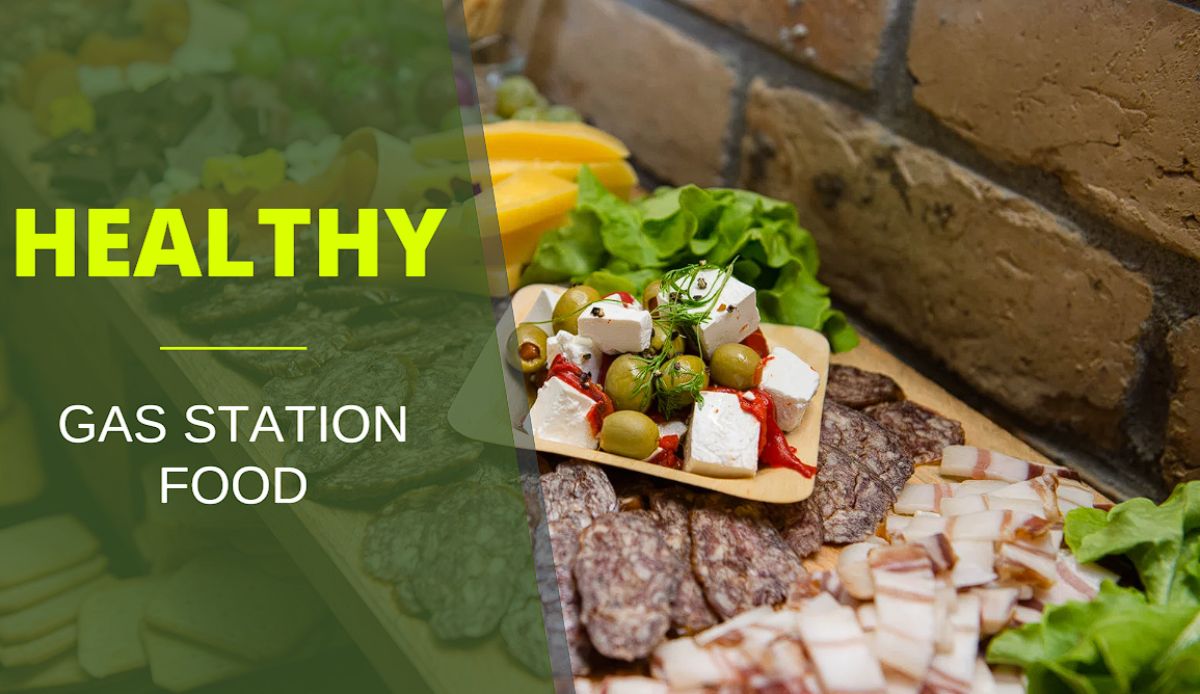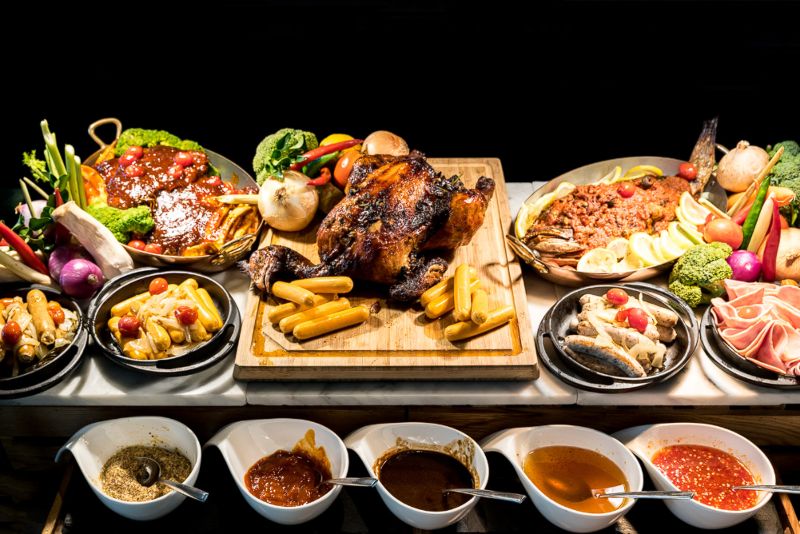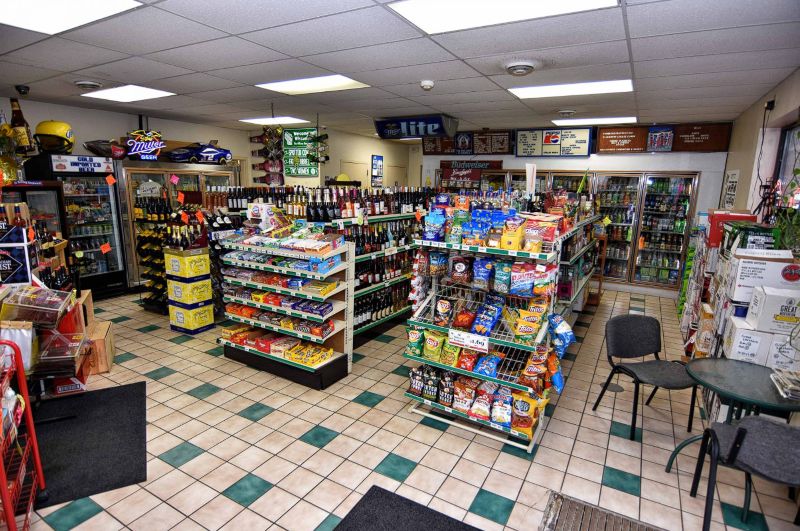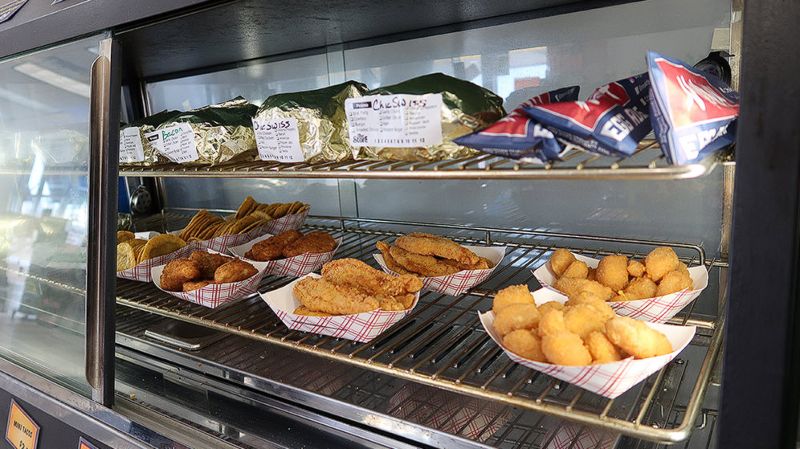Top 7 Healthy Gas Station Food

Healthy Gas Station Food: Gas stations have long been associated with convenient but often unhealthy food options. However, as society’s focus on health and wellness continues to grow, so too does the demand for nutritious alternatives, even on the go. This article delves into the realm of healthy gas station food, delving into its evolution, nutritional considerations, benefits, challenges, and potential solutions.
Table of Contents
Evolution of Gas Station Food
Gas station food has undergone a remarkable evolution over the decades. In the early days of automobile travel, gas stations primarily offered basic amenities like fuel and motor oil. However, as road trips became more common and travelers spent longer hours on the road, the demand for food and refreshments at gas stations grew.
Initially, gas station food options were limited to simple snacks like candy bars, chips, and soft drinks. These items provided a quick energy boost for drivers but lacked nutritional value. As consumer preferences shifted towards healthier eating habits, gas stations began to expand their food offerings to include a wider variety of options.
In recent years, there has been a significant shift towards offering healthier food choices at gas stations. This evolution has been driven by several factors, including changing consumer preferences, increased awareness of the importance of nutrition, and advancements in food production and distribution technologies.
Today, many gas stations offer a diverse range of healthy food options, including fresh salads, fruit cups, yogurt parfaits, and protein bars. Some gas stations have even partnered with local farmers and suppliers to offer locally sourced, organic produce and other wholesome ingredients.
Overall, the evolution of gas station food reflects broader trends in the food industry towards healthier, more sustainable options. While traditional convenience foods like hot dogs and nachos are still available at many gas stations, consumers now have a wider array of choices when it comes to satisfying their hunger on the road. [Healthy Gas Station Food]
Nutritional Considerations
When it comes to choosing healthy gas station food, there are several important nutritional considerations to keep in mind. One of the most critical factors is the balance of macronutrients—carbohydrates, proteins, and fats—in the food.
Ideally, healthy gas station food should provide a balance of these macronutrients to support overall health and well-being. For example, a meal or snack that includes complex carbohydrates, lean proteins, and healthy fats can provide sustained energy and help keep hunger at bay.
In addition to macronutrients, it’s also essential to consider the quality of the ingredients used in gas station food. Fresh, whole foods like fruits, vegetables, whole grains, and lean proteins are generally healthier choices than highly processed foods with artificial additives and preservatives.
Another important consideration is portion size. Even healthy foods can contribute to weight gain and other health problems if consumed in excessive amounts. By practicing portion control and paying attention to serving sizes, consumers can enjoy their favorite gas station treats without overindulging.
Finally, it’s essential to consider the overall nutritional profile of gas station food, including factors like fiber content, sodium levels, and the presence of added sugars. Foods that are high in fiber and low in sodium and added sugars are generally considered healthier options.
By considering these nutritional factors when choosing gas station food, consumers can make informed decisions that support their health and well-being while on the go.

Examples of Healthy Gas Station Food
When it comes to healthy gas station food options, the possibilities are virtually endless. From fresh fruits and vegetables to protein-rich snacks and wholesome meals, there’s something for everyone at the modern gas station convenience store.
One popular option for health-conscious consumers is the pre-packaged salad. Many gas stations now offer a variety of fresh salad options, including classic garden salads, Caesar salads, and chef salads. These salads are typically made with a variety of crisp greens, colorful vegetables, and flavorful dressings, making them a satisfying and nutritious choice for lunch or a light dinner.
Another healthy option available at many gas stations is the fruit cup. These convenient snack packs contain a selection of fresh fruit, such as grapes, pineapple, watermelon, and cantaloupe, providing a refreshing burst of vitamins, minerals, and antioxidants. Fruit cups are an excellent choice for satisfying sweet cravings without resorting to high-calorie, sugar-laden snacks.
For those in need of a quick protein boost, protein bars are a convenient and nutritious option. These bars are typically made with ingredients like nuts, seeds, dried fruit, and protein powder, providing a satisfying combination of protein, fiber, and healthy fats. Protein bars come in a variety of flavors and formulations, making them a versatile choice for on-the-go snacking.
Yogurt parfaits are another popular option for health-conscious consumers. These delicious treats typically consist of layers of creamy yogurt, crunchy granola, and fresh fruit, providing a satisfying blend of protein, carbohydrates, and vitamins. Yogurt parfaits are an excellent choice for breakfast or a mid-morning snack, offering a balance of flavors and textures that is sure to satisfy.
Overall, the key to choosing healthy gas station food is to opt for items that are made with wholesome, nutritious ingredients and balanced macronutrients. By selecting options like salads, fruit cups, protein bars, and yogurt parfaits, consumers can enjoy delicious and satisfying meals and snacks while supporting their health and well-being.
Health Benefits of Healthy Gas Station Food
Choosing healthy gas station food offers numerous benefits for both physical and mental health. By opting for nutritious options like fresh fruits, vegetables, and whole grains, consumers can fuel their bodies with the vitamins, minerals, and antioxidants they need to thrive.
One of the primary benefits of eating healthy gas station food is increased energy levels. Foods that are high in complex carbohydrates and fiber provide a steady source of energy, helping to sustain focus and concentration throughout the day. By contrast, foods that are high in sugar and processed carbohydrates can cause energy levels to spike and crash, leading to feelings of fatigue and lethargy.
In addition to providing sustained energy, healthy gas station food can also support overall health and well-being. Diets that are rich in fruits, vegetables, whole grains, and lean proteins have been linked to a reduced risk of chronic diseases like heart disease, diabetes, and cancer. By choosing foods that are low in saturated fat, cholesterol, and sodium, consumers can help protect their cardiovascular health and reduce their risk of developing these and other serious health conditions.
Furthermore, eating healthy gas station food can also have a positive impact on mental health and mood. Research has shown that diets that are high in fruits, vegetables, and whole grains are associated with a lower risk of depression and anxiety. By fueling their bodies with nutritious foods, consumers can help support their mental health and well-being, promoting a positive outlook and greater resilience in the face of stress and adversity.
Overall, the health benefits of choosing healthy gas station food are numerous and wide-ranging. By opting for nutritious options like fresh fruits, vegetables, and whole grains, consumers can support their physical and mental health while on the go, ensuring they have the energy and vitality they need to live life to the fullest.
Strategies for Making Healthy Choices
Making healthy choices at the gas station convenience store doesn’t have to be complicated. With a few simple strategies, consumers can navigate the aisles with confidence and select options that support their health and well-being.
One of the most important strategies for making healthy choices at the gas station is to read labels carefully. By checking the nutritional information and ingredient list on packaging, consumers can make informed decisions about which items to purchase. Look for products that are low in saturated fat, cholesterol, sodium, and added sugars, and high in fiber, vitamins, and minerals.
Another helpful strategy is to opt for whole foods whenever possible. Fresh fruits, vegetables, whole grains, and lean proteins are generally healthier choices than highly processed snacks and meals. Look for items like salads, fruit cups, nuts, seeds, and yogurt that are made with wholesome ingredients and minimal additives.
Portion control is another key strategy for making healthy choices at the gas station. Even nutritious foods can contribute to weight gain and other health problems if consumed in excessive amounts. By paying attention to portion sizes and avoiding oversized servings, consumers can enjoy their favorite treats without overindulging.
Planning ahead and packing snacks can also help prevent impulsive, less healthy choices at the gas station. By bringing along nutritious options like fresh fruit, cut vegetables, nuts, seeds, and homemade trail mix, consumers can ensure they have healthy snacks on hand when hunger strikes. This can help prevent the temptation to reach for less healthy options like candy bars, chips, and sugary drinks.
By incorporating these strategies into their gas station shopping routine, consumers can make healthier choices that support their health and well-being while on the go. With a little planning and mindfulness, it’s possible to enjoy delicious and satisfying meals and snacks without compromising on nutrition.
Challenges and Solutions
While finding healthy options at the gas station convenience store is easier than ever, there are still some challenges that consumers may encounter. Limited selection, higher prices, and inconsistent quality are common concerns for health-conscious consumers. However, there are several strategies and solutions that can help overcome these challenges and ensure access to nutritious options on the go.
One common challenge is the limited selection of healthy options available at many gas stations. While some convenience stores offer a wide variety of fresh fruits, vegetables, salads, and other nutritious foods, others may have a more limited selection. This can make it difficult for consumers to find the healthy options they’re looking for, especially in rural or underserved areas.
One potential solution to this challenge is to advocate for increased availability of healthy options at gas stations. By voicing their preferences and supporting businesses that offer nutritious choices, consumers can help drive demand for healthier options and encourage gas stations to expand their offerings.
Another challenge is the perception that healthy gas station food is more expensive than less healthy options. While it’s true that some healthier options may be priced higher than their less healthy counterparts, there are still plenty of affordable choices available. By choosing budget-friendly options like fresh fruit, vegetables, nuts, seeds, and yogurt, consumers can enjoy nutritious meals and snacks without breaking the bank.
Inconsistent quality is another challenge that consumers may encounter when shopping for healthy gas station food. While some convenience stores take pride in offering fresh, high-quality products, others may prioritize convenience and affordability over freshness and quality. This can make it difficult for consumers to know which gas stations offer the best options for their needs.
One way to address this challenge is to do some research before visiting a gas station. Many convenience stores now have websites or mobile apps that allow consumers to view their menu options, nutritional information, and customer reviews before making a purchase. By checking online reviews and ratings, consumers can get a better sense of which gas stations offer the highest quality and freshest options.
Overall, while there are some challenges associated with finding healthy options at the gas station convenience store, there are also plenty of solutions available. By advocating for increased availability of healthy options, choosing budget-friendly alternatives, and doing some research before making a purchase, consumers can ensure they have access to nutritious options that support their health and well-being while on the go.

Economic Considerations
One common concern among consumers is the perception that healthy gas station food is more expensive than less healthy options. While it’s true that some healthier options may be priced higher than their less healthy counterparts, there are still plenty of affordable choices available for budget-conscious consumers.
One way to save money on healthy gas station food is to opt for budget-friendly options like fresh fruit, vegetables, nuts, seeds, and yogurt. These items are often priced competitively with less healthy options like candy bars, chips, and sugary drinks, making them an affordable choice for health-conscious consumers.
Another way to save money on healthy gas station food is to take advantage of sales, promotions, and discounts. Many convenience stores offer special deals on fresh produce, snacks, and beverages, making it easy for consumers to stock up on nutritious options without breaking the bank. By keeping an eye out for sales and promotions, consumers can save money while still enjoying delicious and satisfying meals and snacks.
Additionally, consumers can save money on gas station food by planning ahead and packing snacks from home. By bringing along nutritious options like fresh fruit, cut vegetables, nuts, seeds, and homemade trail mix, consumers can avoid the temptation to purchase expensive convenience store snacks and meals while on the go. This can help save money in the long run and ensure access to healthy options wherever the road may take them.
Overall, while there may be some initial costs associated with choosing healthy gas station food, there are plenty of affordable options available for budget-conscious consumers. By opting for budget-friendly alternatives, taking advantage of sales and promotions, and planning ahead, consumers can enjoy nutritious meals and snacks without breaking the bank. [Healthy Gas Station Food]
Environmental Impact
In addition to considering the nutritional value of gas station food, it’s also important to consider its environmental impact. From packaging waste to carbon emissions associated with transportation, the production and distribution of convenience store items can have significant ecological consequences.
One major environmental concern associated with gas station food is packaging waste. Many convenience store items come packaged in single-use plastics, aluminum cans, and other non-biodegradable materials, contributing to the growing problem of plastic pollution in landfills, oceans, and waterways. By choosing items with minimal packaging or opting for reusable alternatives, consumers can help reduce their environmental footprint and minimize waste.
Another environmental consideration is the carbon emissions associated with transporting gas station food from production facilities to retail locations. Many convenience store items are shipped long distances, consuming large amounts of fossil fuels and contributing to greenhouse gas emissions that drive climate change. By choosing locally sourced, sustainably produced foods, consumers can help reduce the environmental impact of their food choices and support local farmers and producers.
Overall, while gas station food may offer convenience and accessibility for consumers on the go, it’s important to consider its environmental impact. By choosing items with minimal packaging, opting for reusable alternatives, and supporting local producers, consumers can help reduce their environmental footprint and promote a more sustainable food system for future generations.
Consumer Education
Empowering consumers to make informed decisions about gas station food is essential for promoting health and well-being. By providing access to accurate information and resources, consumers can make healthier choices that support their individual health goals and preferences.
One important aspect of consumer education is providing access to nutritional information and labeling. Many gas stations now provide detailed nutrition facts for their products, making it easier for consumers to make informed decisions about which items to purchase. By reading labels carefully and comparing options, consumers can choose items that align with their dietary preferences and health needs.
Another important aspect of consumer education is raising awareness about the importance of healthy eating and its impact on overall health and well-being. Public health campaigns, nutrition education programs, and community workshops can help educate consumers about the benefits of choosing nutritious options and provide them with the knowledge and skills they need to make healthier choices.
In addition to providing access to information and resources, it’s also important to address barriers to healthy eating and provide support for consumers who may struggle to access or afford nutritious options. This may include advocating for increased availability of healthy options at gas stations, offering subsidies or discounts for healthy foods, and providing assistance with meal planning and preparation.
Overall, consumer education plays a crucial role in promoting health and well-being and empowering consumers to make informed decisions about gas station food. By providing access to information, resources, and support, consumers can make healthier choices that support their individual health goals and preferences, leading to improved health outcomes and greater overall well-being. [Healthy Gas Station Food]
Regulatory Framework
While there are some regulations governing the quality and labeling of gas station food, there is room for improvement in many areas. Strengthening standards for food safety, ingredient transparency, and nutritional labeling can help protect consumers and ensure they have access to accurate information when making purchasing decisions.
One area where regulations could be strengthened is food safety. While gas station food is generally subject to the same food safety regulations as other types of food sold in retail establishments, there may be gaps in enforcement or oversight that put consumers at risk. Strengthening regulations related to food handling, storage, and preparation can help ensure that gas station food is safe and free from contamination.
Another area where regulations could be improved is ingredient transparency. While many gas station food items now include detailed nutrition facts on their packaging, there may still be inconsistencies or inaccuracies in labeling that make it difficult for consumers to make informed decisions about which items to purchase. Strengthening regulations related to ingredient labeling and disclosure can help ensure that consumers have access to accurate information about the products they’re buying.
Additionally, regulations related to nutritional labeling could be strengthened to provide consumers with more detailed information about the nutritional content of gas station food items. This may include requiring gas stations to provide calorie counts, serving sizes, and other nutritional information for all of their products, making it easier for consumers to make informed decisions about which items to purchase.
Overall, while there are some regulations in place governing the quality and labeling of gas station food, there is room for improvement in many areas. By strengthening standards for food safety, ingredient transparency, and nutritional labeling, policymakers can help protect consumers and ensure they have access to accurate information when making purchasing decisions. [Healthy Gas Station Food]

Community Engagement
Gas stations have the potential to serve as hubs for community health and wellness initiatives. By partnering with local organizations, hosting nutrition workshops, and supporting initiatives such as food banks and community gardens, gas stations can foster a sense of belonging and contribute to the overall well-being of their neighborhoods.
One way that gas stations can engage with their communities is by partnering with local farmers and suppliers to offer fresh, locally sourced produce and other wholesome ingredients. By supporting local producers, gas stations can promote sustainability, reduce food miles, and provide consumers with access to high-quality, nutritious foods.
Another way that gas stations can engage with their communities is by hosting nutrition workshops and educational events. These events can provide consumers with valuable information about healthy eating, meal planning, and cooking skills, empowering them to make healthier choices for themselves and their families.
Gas stations can also support community health and wellness initiatives by donating to local food banks and organizations that work to alleviate food insecurity. By providing nutritious food options to those in need, gas stations can help improve access to healthy food and promote food justice in their communities.
Overall, community engagement plays a crucial role in promoting health and wellness at gas stations. By partnering with local organizations, hosting educational events, and supporting initiatives that promote access to healthy food, gas stations can make a positive impact on the health and well-being of their communities. [Healthy Gas Station Food]
Technological Innovations
Advancements in technology are shaping the future of gas station food in exciting ways. From mobile apps and online platforms to innovations in food production and packaging, technology has the potential to revolutionize the way we access, purchase, and consume gas station food.
One area where technology is making a big impact is in the realm of mobile apps and online platforms. Many gas stations now offer mobile apps that allow consumers to order food ahead of time, customize their orders, and pay for their purchases seamlessly. These apps can also provide users with real-time information about available options, nutritional content, and special promotions, making it easier than ever for consumers to make informed decisions about their food choices.
Another area where technology is driving innovation in gas station food is in food production and packaging. Advancements in food science and engineering are making it possible to produce healthier, more sustainable food options that are convenient and affordable for consumers. From plant-based meat alternatives to biodegradable packaging materials, these innovations are helping to reshape the gas station food landscape in exciting ways.
Additionally, technology is also playing a role in improving the safety and quality of gas station food. From advanced food safety monitoring systems to blockchain-based supply chain tracking, technology is helping to ensure that gas station food is safe, fresh, and free from contamination. These advancements can help build consumer trust and confidence in the quality of gas station food, leading to increased sales and customer satisfaction.
Overall, technological innovations are transforming the gas station food industry in exciting ways. By leveraging the power of mobile apps, online platforms, and advancements in food production and packaging, gas stations can provide consumers with access to healthier, more sustainable food options that meet their needs and preferences. [Healthy Gas Station Food]
Cultural Considerations
Cultural preferences and dietary traditions play a significant role in shaping food choices, even at gas stations. Recognizing and respecting diverse cultural needs and preferences is essential for ensuring that all consumers have access to foods that align with their values and traditions.
One way that gas stations can cater to diverse cultural needs is by offering a variety of ethnic and international food options. From sushi and stir-fry to tacos and tamales, gas stations can provide consumers with access to a wide range of flavors and cuisines that reflect the diversity of their communities. By offering culturally diverse food options, gas stations can attract a broader customer base and provide consumers with the opportunity to explore new and exciting culinary experiences.
Another way that gas stations can accommodate cultural preferences is by providing options for specific dietary restrictions and preferences. For example, many gas stations now offer vegetarian, vegan, gluten-free, and dairy-free options for consumers with special dietary needs. By offering a variety of menu choices, gas stations can ensure that all consumers have access to foods that meet their individual preferences and requirements.
Additionally, gas stations can also incorporate cultural elements into their marketing and promotional efforts. From celebrating cultural holidays and festivals to featuring culturally diverse advertising campaigns, gas stations can create a welcoming and inclusive atmosphere that resonates with consumers from all walks of life.
Overall, cultural considerations play a crucial role in shaping food choices at gas stations. By recognizing and respecting diverse cultural needs and preferences, gas stations can create an inclusive and welcoming environment that caters to the unique tastes and preferences of their customers.

Conclusion
In conclusion, healthy gas station food is no longer an oxymoron but a viable option for consumers seeking nutritious meals and snacks on the go. By understanding the evolution of gas station food, considering nutritional factors, and embracing strategies for making healthier choices, consumers can prioritize their health without sacrificing convenience.
Through continued advocacy, education, and innovation, the gas station food industry has the potential to become a catalyst for positive change in public health and environmental sustainability. By promoting access to nutritious options, supporting community health and wellness initiatives, and leveraging technological innovations, gas stations can make a meaningful impact on the health and well-being of their customers and communities. [Healthy Gas Station Food]
FAQs
Q1. Are all gas station food options unhealthy?
No, many gas stations now offer a variety of nutritious options alongside traditional convenience foods. From fresh salads and fruit cups to protein bars and yogurt parfaits, there are plenty of healthy choices available for health-conscious consumers.
Q2. How can I find healthy options at a gas station?
Look for items labeled as “fresh,” “low-fat,” or “high-protein,” and opt for whole foods whenever possible. Fresh fruits, vegetables, salads, nuts, seeds, and yogurt are all excellent choices for health-conscious consumers.
Q3. Are healthy gas station foods more expensive?
While some healthy options may be priced higher than their less healthy counterparts, there are often affordable choices available, especially when considering the long-term health benefits. By choosing budget-friendly options like fresh produce and bulk snacks, consumers can enjoy nutritious meals and snacks without breaking the bank.
Q4. Can I trust the nutritional information provided by gas station food labels?
It’s essential to read labels carefully and be aware of potential discrepancies or inaccuracies in nutritional information. While many gas stations now provide detailed nutrition facts for their products, it’s always a good idea to double-check the information and compare options to make the most informed decisions about which items to purchase.
Q5. What should I do if I can’t find healthy options at a gas station?
In cases where healthy options are limited, consider bringing your own snacks or meals from home to ensure you have nutritious options available. Fresh fruit, cut vegetables, nuts, seeds, and homemade trail mix are all excellent choices for on-the-go snacking and can help you stay on track with your health goals even when healthy options are scarce.






